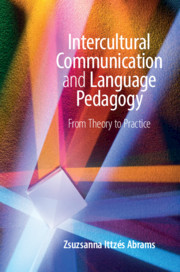Description
Intercultural Communication and Language Pedagogy
From Theory To Practice
Author: Abrams Zsuzsanna Ittzés
Using diverse language examples and tasks, this book illustrates how intercultural communication theory can inform second language teaching.
Language: English
Subject for Intercultural Communication and Language Pedagogy:
Approximative price 39.35 €
In Print (Delivery period: 14 days).
Add to cart
Intercultural Communication and Language Pedagogy
Publication date: 08-2020
280 p. · 15.3x23 cm · Paperback
Publication date: 08-2020
280 p. · 15.3x23 cm · Paperback
Approximative price 101.56 €
In Print (Delivery period: 14 days).
Add to cart
Intercultural Communication and Language Pedagogy
Publication date: 08-2020
280 p. · 23.5x15.5 cm · Hardback
Publication date: 08-2020
280 p. · 23.5x15.5 cm · Hardback
Description
/li>Contents
/li>Biography
/li>
Learning a new language offers a unique opportunity to discover other cultures as well as one's own. This discovery process is essential for developing 21st-century intercultural communication skills. To help prepare language teachers for their role as guides during this process, this book uses interdisciplinary research from social sciences and applied linguistics on intercultural communication for designing teaching activities that are readily implemented in the language classroom. Diverse language examples are used throughout the book to illustrate theoretical concepts, making them accessible to language teachers at all skill levels. The chapters introduce various perspectives on culture, intercultural communicative competence, analyzing authentic language data, teaching foreign/second languages with an intercultural communication orientation, the intercultural journey, the language-culture-identity connection, as well as resolving miscommunication and cultural conflict. While the immediate audience of this book is language teachers, the ultimate beneficiaries are language learners interested in undertaking the intercultural journey.
Introduction; Part I. Theoretical and Methodological Foundations: 1. Key Concepts in Intercultural Communication; 2. Pedagogical Foundations of Teaching ICC for L2/Lx Use; 3. The Learner as Analyst: Methods and Sources of Data Analysis; Part II. Pedagogical Implementation: 4. Intercultural Communication: Teaching Vocabulary; 5. Intercultural Communication: Teaching Grammar; 6. Intercultural Communication: Teaching Pragmatics; 7. Intercultural Communication: Teaching Paralinguistic Features; 8. Intercultural Communication: Teaching Nonverbal Communication; 9. Intercultural Communication: Teaching Cultural Knowledge; 10. Assessing Intercultural Communication; Part III. Intercultural Communication and the Personal Journey: 11. Cultural Transitions; Cultures and Identities; 13. Miscommunication, Conflict and Intercultural Communicative Competence; Appendix.
Zsuzsanna Ittzés Abrams is Professor of Linguistics at the University of California. Originally from Hungary, she has been fascinated by intercultural existence since age 10, when her family spent eighteen months in Libya. She has contributed to a range of edited volumes, most recently Understanding Attitude in Intercultural Virtual Communication (eds. A. Oskoz & M. Vinagre) and has published articles in a range of journals, including Die Unterrichtspraxis, L2 Journal, The Re-CALL Journal and The CALICO Journal.
© 2024 LAVOISIER S.A.S.




